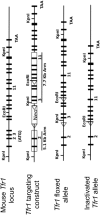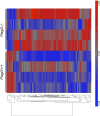Noncanonical role of transferrin receptor 1 is essential for intestinal homeostasis
- PMID: 26324903
- PMCID: PMC4577163
- DOI: 10.1073/pnas.1511701112
Noncanonical role of transferrin receptor 1 is essential for intestinal homeostasis
Abstract
Transferrin receptor 1 (Tfr1) facilitates cellular iron uptake through receptor-mediated endocytosis of iron-loaded transferrin. It is expressed in the intestinal epithelium but not involved in dietary iron absorption. To investigate its role, we inactivated the Tfr1 gene selectively in murine intestinal epithelial cells. The mutant mice had severe disruption of the epithelial barrier and early death. There was impaired proliferation of intestinal epithelial cell progenitors, aberrant lipid handling, increased mRNA expression of stem cell markers, and striking induction of many genes associated with epithelial-to-mesenchymal transition. Administration of parenteral iron did not improve the phenotype. Surprisingly, however, enforced expression of a mutant allele of Tfr1 that is unable to serve as a receptor for iron-loaded transferrin appeared to fully rescue most animals. Our results implicate Tfr1 in homeostatic maintenance of the intestinal epithelium, acting through a role that is independent of its iron-uptake function.
Keywords: epithelial–mesenchymal transition; homeostasis; intestinal epithelium; stem cell; transferrin receptor.
Conflict of interest statement
The authors declare no conflict of interest.
Figures











Similar articles
-
The transferrin receptor: the cellular iron gate.Metallomics. 2017 Oct 18;9(10):1367-1375. doi: 10.1039/c7mt00143f. Metallomics. 2017. PMID: 28671201 Review.
-
Effects of cell proliferation on the uptake of transferrin-bound iron by human hepatoma cells.Hepatology. 2003 Oct;38(4):967-77. doi: 10.1053/jhep.2003.50422. Hepatology. 2003. PMID: 14512884
-
Transferrin receptor 1-mediated iron uptake plays an essential role in hematopoiesis.Haematologica. 2020 Aug;105(8):2071-2082. doi: 10.3324/haematol.2019.224899. Epub 2019 Oct 10. Haematologica. 2020. PMID: 31601687 Free PMC article.
-
Brain iron homeostasis.Dan Med Bull. 2002 Nov;49(4):279-301. Dan Med Bull. 2002. PMID: 12553165 Review.
-
Intestinal transferrin receptors and iron absorption in the neonatal rat.Br J Haematol. 1991 Feb;77(2):229-36. doi: 10.1111/j.1365-2141.1991.tb07982.x. Br J Haematol. 1991. PMID: 2004025
Cited by
-
Prenatal Alcohol Exposure Alters Fetal Iron Distribution and Elevates Hepatic Hepcidin in a Rat Model of Fetal Alcohol Spectrum Disorders.J Nutr. 2016 Jun;146(6):1180-8. doi: 10.3945/jn.115.227983. Epub 2016 May 4. J Nutr. 2016. PMID: 27146918 Free PMC article.
-
Nutrition impact on ILC3 maintenance and function centers on a cell-intrinsic CD71-iron axis.Nat Immunol. 2023 Oct;24(10):1671-1684. doi: 10.1038/s41590-023-01612-z. Epub 2023 Sep 14. Nat Immunol. 2023. PMID: 37709985 Free PMC article.
-
Iron metabolism and iron disorders revisited in the hepcidin era.Haematologica. 2020 Jan 31;105(2):260-272. doi: 10.3324/haematol.2019.232124. Print 2020. Haematologica. 2020. PMID: 31949017 Free PMC article. Review.
-
Iron Metabolism in Liver Cancer Stem Cells.Front Oncol. 2019 Mar 19;9:149. doi: 10.3389/fonc.2019.00149. eCollection 2019. Front Oncol. 2019. PMID: 30941302 Free PMC article. Review.
-
Muscle specific iron deficiency has systemic consequences.EBioMedicine. 2015 Oct 5;2(11):1582-3. doi: 10.1016/j.ebiom.2015.10.001. eCollection 2015 Nov. EBioMedicine. 2015. PMID: 26870775 Free PMC article. No abstract available.
References
-
- Hentze MW, Muckenthaler MU, Andrews NC. Balancing acts: Molecular control of mammalian iron metabolism. Cell. 2004;117(3):285–297. - PubMed
-
- Levy JE, Jin O, Fujiwara Y, Kuo F, Andrews NC. Transferrin receptor is necessary for development of erythrocytes and the nervous system. Nat Genet. 1999;21(4):396–399. - PubMed
-
- Ned RM, Swat W, Andrews NC. Transferrin receptor 1 is differentially required in lymphocyte development. Blood. 2003;102(10):3711–3718. - PubMed
-
- Trenor CC, 3rd, Campagna DR, Sellers VM, Andrews NC, Fleming MD. The molecular defect in hypotransferrinemic mice. Blood. 2000;96(3):1113–1118. - PubMed
Publication types
MeSH terms
Substances
Associated data
- Actions
Grants and funding
LinkOut - more resources
Full Text Sources
Other Literature Sources
Molecular Biology Databases
Miscellaneous

